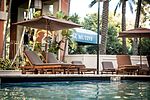Coconut Grove Convention Center
2013 disestablishments in FloridaAmerican Basketball Association venuesBasketball venues in FloridaDefunct basketball venues in the United StatesDefunct indoor arenas in Florida ... and 5 more
Demolished sports venues in FloridaFlorida sports venue stubsMiami building and structure stubsSports venues demolished in 2013Sports venues in Miami
The Coconut Grove Convention Center (formerly the Dinner Key Auditorium, also known as the Coconut Grove Expo Center), was an indoor arena and exhibition hall in Miami, Florida. It originally had been built as a hangar at International Pan American Airport in Dinner Key. The venue closed in 2005 and was used as a production studio for six years. The building was demolished in 2013 and the site is now home to Regatta Park.
Excerpt from the Wikipedia article Coconut Grove Convention Center (License: CC BY-SA 3.0, Authors).Coconut Grove Convention Center
South Bayshore Drive, Miami
Geographical coordinates (GPS) Address Nearby Places Show on map
Geographical coordinates (GPS)
| Latitude | Longitude |
|---|---|
| N 25.728391 ° | E -80.236465 ° |
Address
South Bayshore Drive
South Bayshore Drive
33133 Miami
Florida, United States
Open on Google Maps










